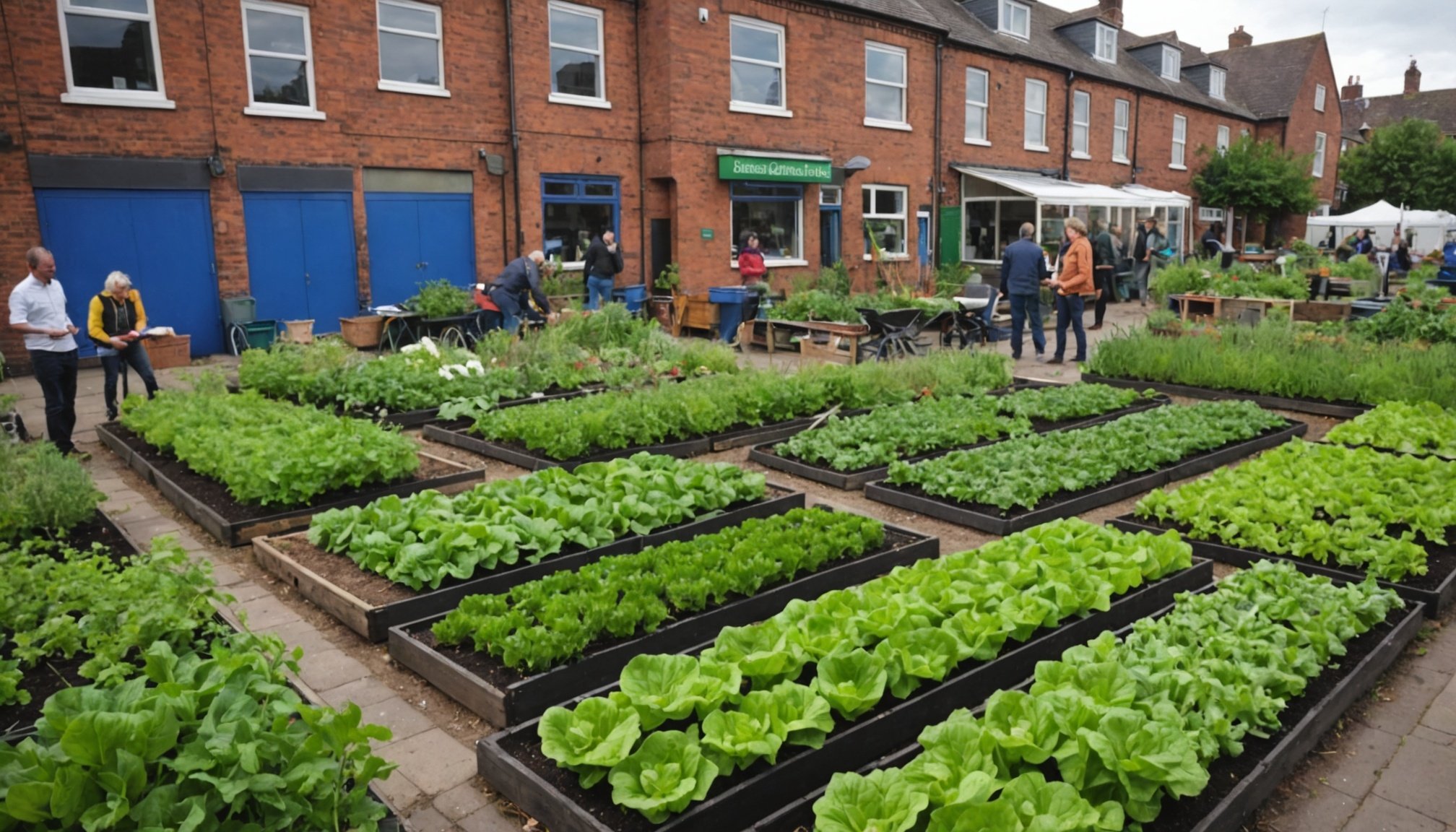Understanding Urban Agriculture
Urban agriculture is gaining attention in the UK as more people embrace its potential to transform cities. The concept involves growing food within urban areas, making fresh produce accessible to city dwellers and reducing the carbon footprint associated with transporting food long distances. In this context, forming a farming collective can offer numerous benefits over individual farming efforts.
Collaboratives utilize shared resources, such as tools and knowledge, enhancing productivity and innovation. They also create a sense of community, increasing success rates through mutual support and responsibility. This collective approach aligns perfectly with sustainability practices, which are crucial in urban settings where space and resources are limited.
Also to see : Key guidelines for uk event management companies to stay compliant with public liability insurance regulations
Key sustainability practices include water conservation through the use of rainwater harvesting systems and soil revitalization to maintain healthy crops. Also, employing vertical gardening techniques maximizes space efficiency in densely populated areas. These practices not only support urban agriculture efforts but also contribute to wider environmental goals by promoting biodiversity, reducing waste, and fostering greener cities.
Urban agriculture is not just about food production; it’s a step towards a more sustainable and engaged urban community that actively participates in ecological preservation and societal well-being. It encourages city residents to rethink the way they interact with their environment.
Have you seen this : Key strategies for uk renewable energy startups to successfully manage environmental impact assessments
Legal Considerations for Farming Collectives
The landscape of urban farming in the UK is shaped by diverse legal requirements and regulations. Key among these are cooperative laws that influence the formation and operation of farming collectives. Understanding these regulations is crucial for any urban farming initiative.
In the UK, there are specific regulations tailored to guide urban farming operations. Compliance with these regulations ensures that your collective operates legally and sustainably. These legal frameworks are designed to support the growth of urban farms while addressing environmental and societal impacts.
When establishing a farming collective, choosing the right legal structure is essential. Cooperatives, for example, offer a democratic framework where members have equal say in decision-making. This can foster a sense of community and shared responsibility. Additionally, cooperatives can benefit from certain tax advantages and grants aimed at supporting sustainable practices.
Compliance with local zoning laws, environmental regulations, and health and safety standards is mandatory. These regulations ensure that urban farming initiatives are safe for both participants and consumers. Engaging with local authorities can provide clarity and guidance on these compliance aspects.
By understanding and navigating these legal structures and regulations, urban farming collectives can operate efficiently and legally, providing fresh, local produce to communities.
Strategies for Establishing a Successful Farming Collective
The journey towards establishing a collective begins with actively engaging the community. Identifying community needs and interests is crucial. By understanding what drives your community, you can tailor the collective to suit everyone involved. To foster connection and collaboration, hosting initial meetings and workshops becomes essential. These gatherings provide the platform for discussion, allowing potential members to voice concerns, expectations, and ideas. Building support and enthusiasm among potential members ensures a robust foundation from which the collective can grow.
Initiating Community Engagement
To create a thriving farming collective, focusing on community building is key. Begin by exploring local needs. This might involve surveys, informal talks, or public forums to gather diverse insights. Workshops then serve as a dynamic space for exchange, breaking down barriers and establishing trust. During these engagements, it’s important to communicate the benefits of collaborative strategies, highlighting shared resources and knowledge.
Developing a Governance Structure
Once community engagement is underway, developing a governance structure becomes vital. Defining roles and responsibilities within the collective helps maintain clarity and order. It’s essential to create inclusive decision-making processes, ensuring all voices are heard. Managing conflict proactively through effective communication strategies strengthens the group’s unity, paving the way for smooth operations and long-term success.
Funding Sources for Urban Agriculture Initiatives
Securing funding opportunities is imperative for the growth and success of urban agriculture initiatives. In today’s landscape, there are various avenues to explore, including government and NGO grants. These grants can provide essential financial resources to jumpstart or sustain urban agriculture projects. When applying for these, it’s crucial to present well-structured grant applications that clearly outline the project’s goals and benefits.
In addition to traditional grants, innovative funding models such as crowdfunding and community investment have become viable alternatives. Crowdfunding allows projects to reach potential donors globally, while community investment engages local residents financially, fostering a sense of ownership and commitment. These models can be highly effective in rallying support and ensuring financial viability.
Financial planning plays a pivotal role in sustaining urban agriculture collectives. Without it, the risk of depleting resources quickly becomes a reality. Strategic planning should include a detailed analysis of income sources, potential expenses, and a clear roadmap for future financial gains. This ensures a stable foundation for the initiative, enabling it to thrive in the competitive landscape of urban farming.
By exploring diverse funding models and maintaining robust financial strategies, urban agriculture initiatives can achieve long-term sustainability and impact.
Case Studies of Successful Urban Farming Collectives
Examining the landscape of urban farming collectives in the UK reveals intriguing success stories and effective best practices. Within local communities, several notable examples showcase the transformative power of these initiatives.
Analysis of UK-Based Farming Collectives
In London, the Growing Communities initiative stands out, significantly improving food security and enhancing community cohesion. Their strategy involves engaging local residents in organic farming, promoting inclusive community-supported agriculture. Similarly, the Incredible Edible movement in Todmorden has revitalised public spaces by converting them into thriving, edible landscapes. These projects emphasise the importance of community involvement and environmental sustainability. Lessons learned from such examples highlight the effectiveness of grassroots participation and awareness campaigns in fostering sustainable urban agriculture.
Comparison with Global Urban Agriculture Models
International case studies also provide valuable insights. In Havana, Cuba’s organoponicos demonstrate resilience through state-supported urban farming, integrating local resources efficiently. Meanwhile, Detroit’s urban farms have spurred economic revitalisation through innovative land use. These models underline shared challenges such as limited space and resources. However, adaptability is key, as global practices might not always directly apply to the UK context. Instead, best practices can be tailored, ensuring local resilience and sustainability are achieved through flexibility and creative solutions.
Tools and Resources for Collaboration
In the expanding field of urban agriculture, collaboration tools and community resources are instrumental in enhancing communication and fostering collective growth. Digital platforms like Slack and Microsoft Teams are central to this progression. These platforms facilitate seamless communication, allowing urban farmers and enthusiasts to share ideas, discuss challenges, and develop innovative solutions from virtually anywhere.
Training resources specifically geared towards urban agriculture skill development are increasingly available on these digital platforms. Platforms such as Coursera and edX offer online courses that provide comprehensive training modules, enabling individuals to acquire crucial skills at their own pace. These resources are vital for nurturing proficient urban farmers who can implement practices that are both sustainable and productive.
The significance of networking within the urban agriculture community cannot be overstated. Establishing strong networks facilitates the sharing of knowledge, experiences, and best practices, which is integral for both individual and community development. Events hosted on community resources like Meetup and Eventbrite provide opportunities for urban agriculture enthusiasts to connect, collaborate, and support each other’s initiatives. This collective effort not only strengthens individual projects but also contributes to the overall sustainability and evolution of urban agriculture practices worldwide.
Sustainability Practices in Urban Farming
Harnessing sustainable practices in urban farming can profoundly impact city environments by reducing carbon footprints and promoting ecological health.
Overview of Sustainable Farming Techniques
In urban settings, several sustainable techniques can be applied to enhance productivity while maintaining ecological balance. Practices like vertical farming, which utilizes controlled environments to maximize space, are crucial. Composting is another technique that recycles organic waste into nutrient-rich soil, closing the loop in urban waste management.
Benefits of Biodiversity
Prioritizing biodiversity within urban farms fosters resilience against pests and diseases, reducing dependency on chemicals. Diversified species and crops can adapt better to changing environmental conditions, ensuring a consistent yield. Additionally, increased biodiversity attracts beneficial insects and pollinators, which enhance crop productivity.
Resources for Eco-Friendly Farming
To implement eco-friendly farming practices, resources such as community workshops and digital platforms provide valuable information on sustainable techniques. Local government programs may offer incentives for adopting such practices, while urban farming collectives often share resources and collaborate on innovative methods.
By integrating these concepts, urban farmers can contribute to a more environmentally friendly urban landscape, promoting sustainability in everyday city life.











